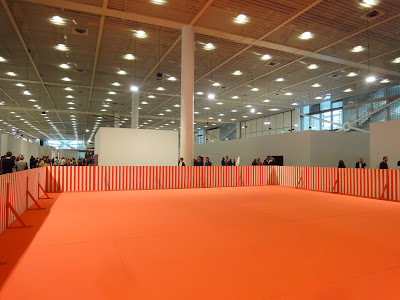After the successful introduction to Art Basel last year by Jens Hoffman, the Art Parcours program returned this year for its second edition in the St. Alban Tal area along the Rhine. The idea was to create a strong interaction with Basel's past and present, weaving artistic interventions into the fabric of the historic city. "The fair halls are so clean and proper and without much character that the historical buildings that we have chosen seem like the best contrast," Hoffman explained. In my opinion, it was exactly this contrast that made Art Parcours a million times more interesting.
Some of the venues were old houses in the neighborhood. Gabriel Sierra inserted various wooden structures in the different rooms of Raum33, marking the spatial sequence between the street and the riverfront. Anne Chu covered the floor of Hohen Dolder House with large rugs inspired by the deer-antler motifs in the surrounding murals.
 |
| Gabriel Sierra, Untitled, Estructures for transition #9 |
 |
| Anne Chu, A resting place with William Tell |
Janet Cardiff and George Bures Miller showed their playfulness in the pop-up bar inside an old water reservoir. Through a heavy old door and a dimly-lit staircase, you entered a vaulted space with a tiki hut in the middle. There were dancing waves projected on the damp walls, tropical music playing in the background, and a couple of bartenders serving you colorful fruity cocktails.
 |
| Janet Cardiff and George Bures Miller, Blue Hawaii Bar |
On a cargo ship, Chris Johanson built a stage for his own Art Parcours Night performance with his band Sun Foot. I don't know how it looked during the party. But in the day, it didn't find it so appealing.
 |
| Chris Johanson / Sun Foot, An Evening of Going Through Things and Looking at Each Other with Each Other |
Along the river bank, Costa Rican artist Federico Herrero painted four fishing huts with colors and shapes from his hometown San José, bringing an unusual festive atmosphere to the quite Swiss town.
 |
| Federico Herrero, Vibrantes |
It was ironic to see Ai Weiwei's work on the old city wall. In a way, these remains of the medieval fortification reminded me of the various walls in China and the artist in prison.
 |
| Ai Weiwei, Fairytale People |
In front of the Museum of Contemporary Art, Yinka Shonibare "decorated" the trees along the river with hundreds of kites of different colors and patterns. They could be flying or trapped, depending on your mood when you saw it I guess.
 |
| Yinka Shonibare, 500 Kites |
Three sculptures by Ugo Rondinone from the Scholar Rocks series were placed in the St. Alban churchyard. Well, you know what it is - I don't have too much to say about this.
 |
| Ugo Rondinone, Scholar Rocks |
The best work of all was inside the St. Alban Church, where Belgian artist Kris Martin covered the floor with innumerable tiny bronze discs. It was extremely moving because of the multiple layers of dual qualities: subtlety and strong presence; playfulness and sublime; specificity and ambiguity; form and formless; transience and eternity. It gave us a great example of well-balanced intervention and interaction.
 |
| Kris Martin, Festum II |









































